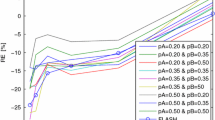Abstract
This study presents two cases of tumors in contact with the inferior vena cava during radiotherapy, and introduces a clinically useful technique for identifying tumor boundaries adjacent to blood vessels by adjusting the position of the field-of-view (FOV) to enhance the inflow effect in magnetic resonance imaging. We named this technique “Shifting-FOV.” This method consists of three steps: (1) remove the upper and lower saturation pulses outside the FOV, (2) align the FOV to position the lower edge of the imaging slab as close to the tumor as possible, and (3) manually adjust the table position to locate the tumor at the center of the magnetic field. The proposed method allowed for accurate identification of the tumor/vessel boundaries in both cases. This is a useful technique that can be readily applied to other facilities. Furthermore, images obtained using this technique may enable accurate tumor contouring in radiotherapy treatment planning.



Similar content being viewed by others
References
Moore-Palhares D, Ho L, Lu L, Chugh B, Vesprini D, Karam I, Soliman H, Symons S, Leung E, Loblaw A, Myrehaug S, Stanisz G, Sahgal A, Czarnota GJ. Clinical implementation of magnetic resonance imaging simulation for radiation oncology planning: 5 year experience. Radiat Oncol. 2023;18(1):27. https://doi.org/10.1186/s13014-023-02209-4.
Otazo R, Lambin P, Pignol JP, Ladd ME, Schlemmer HP, Baumann M, Hricak H. MRI-guided radiation therapy: an emerging paradigm in adaptive radiation oncology. Radiology. 2021;298(2):248–60. https://doi.org/10.1148/radiol.2020202747.
Usui K, Sasai K, Ogawa K. Effect of region extraction and assigned mass-density values on the accuracy of dose calculation with magnetic resonance-based volumetric arc therapy planning. Radiol Phys Technol. 2018;11(2):174–83. https://doi.org/10.1007/s12194-018-0452-7.
Axel L, Shimakawa A, MacFall J. A time-of-flight method of measuring flow velocity by magnetic resonance imaging. Magn Reson Imaging. 1986;4(3):199–205. https://doi.org/10.1016/0730-725x(86)91059-3.
Fujiwara Y, Ishimori Y, Yamaguchi I, Kosaka N, Kimura H, Adachi T. Fat-subtracted three-dimensional time-of-flight MR angiography of the neck by use of fat-only images with the two-point Dixon technique. Radiol Phys Technol. 2015;8(2):193–9. https://doi.org/10.1007/s12194-015-0307-4.
Chien D, Edelman RR. Basic principles and clinical applications of magnetic resonance angiography. Semin Roentgenol. 1992;27(1):53–62. https://doi.org/10.1016/0037-198x(92)90046-5.
Rofsky NM, Lee VS, Laub G, Pollack MA, Krinsky GA, Thomasson D, Ambrosino MM, Weinreb JC. Abdominal MR imaging with a volumetric interpolated breath-hold examination. Radiology. 1999;212(3):876–84. https://doi.org/10.1148/radiology.212.3.r99se34876.
Yu MH, Lee JM, Yoon JH, Kiefer B, Han JK, Choi BI. Clinical application of controlled aliasing in parallel imaging results in a higher acceleration (CAIPIRINHA)-volumetric interpolated breathhold (VIBE) sequence for gadoxetic acid-enhanced liver MR imaging. J Magn Reson Imaging. 2013;38(5):1020–6. https://doi.org/10.1002/jmri.24088.
Kato Y, Okudaira K, Kamomae T, Kumagai M, Nagai Y, Taoka T, Itoh Y, Naganawa S. <Editors’ Choice> Evaluation of system-related magnetic resonance imaging geometric distortion in radiation therapy treatment planning: two approaches and effectiveness of three-dimensional distortion correction. Nagoya J Med Sci. 2022;84(1):29–41. https://doi.org/10.18999/nagjms.84.1.29.
Kumagai M, Kawamura M, Kato Y, Okudaira K, Naganawa S. The impact of system-related magnetic resonance imaging geometric distortion in stereotactic radiotherapy: a case report. Cureus. 2022;14(7): e27269. https://doi.org/10.7759/cureus.27269.
Ichikawa T, Sano K, Morisaka H. Diagnosis of pathologically early HCC with EOB-MRI: experiences and current consensus. Liver Cancer. 2014;3(2):97–107. https://doi.org/10.1159/000343865.
Yang B, Chiu TL, Law WK, Geng H, Lam WW, Leung TM, Yiu LH, Cheung KY, Yu SK. Performance evaluation of the CyberKnife system in real-time target tracking during beam delivery using a moving phantom coupled with two-dimensional detector array. Radiol Phys Technol. 2019;12(1):86–95. https://doi.org/10.1007/s12194-018-00495-2.
Author information
Authors and Affiliations
Corresponding author
Ethics declarations
Conflict of interest
All the authors declare that they have no conflicts of interest regarding this manuscript.
Ethical approval
All the procedures involving human participants performed in this study were in accordance with the ethical standards of our Institutional Review Board (IRB, No: 2023-0149) and the 1964 Helsinki Declaration and its later amendments or comparable ethical standards. This article does not report any animal studies.
Additional information
Publisher's Note
Springer Nature remains neutral with regard to jurisdictional claims in published maps and institutional affiliations.
About this article
Cite this article
Kato, Y., Okudaira, K., Noguchi, Y. et al. Shifting-field-of-view technique enhancing the inflow effect for identifying tumor/vessel boundaries in MRI for radiotherapy treatment planning. Radiol Phys Technol 16, 578–583 (2023). https://doi.org/10.1007/s12194-023-00745-y
Received:
Revised:
Accepted:
Published:
Issue Date:
DOI: https://doi.org/10.1007/s12194-023-00745-y




